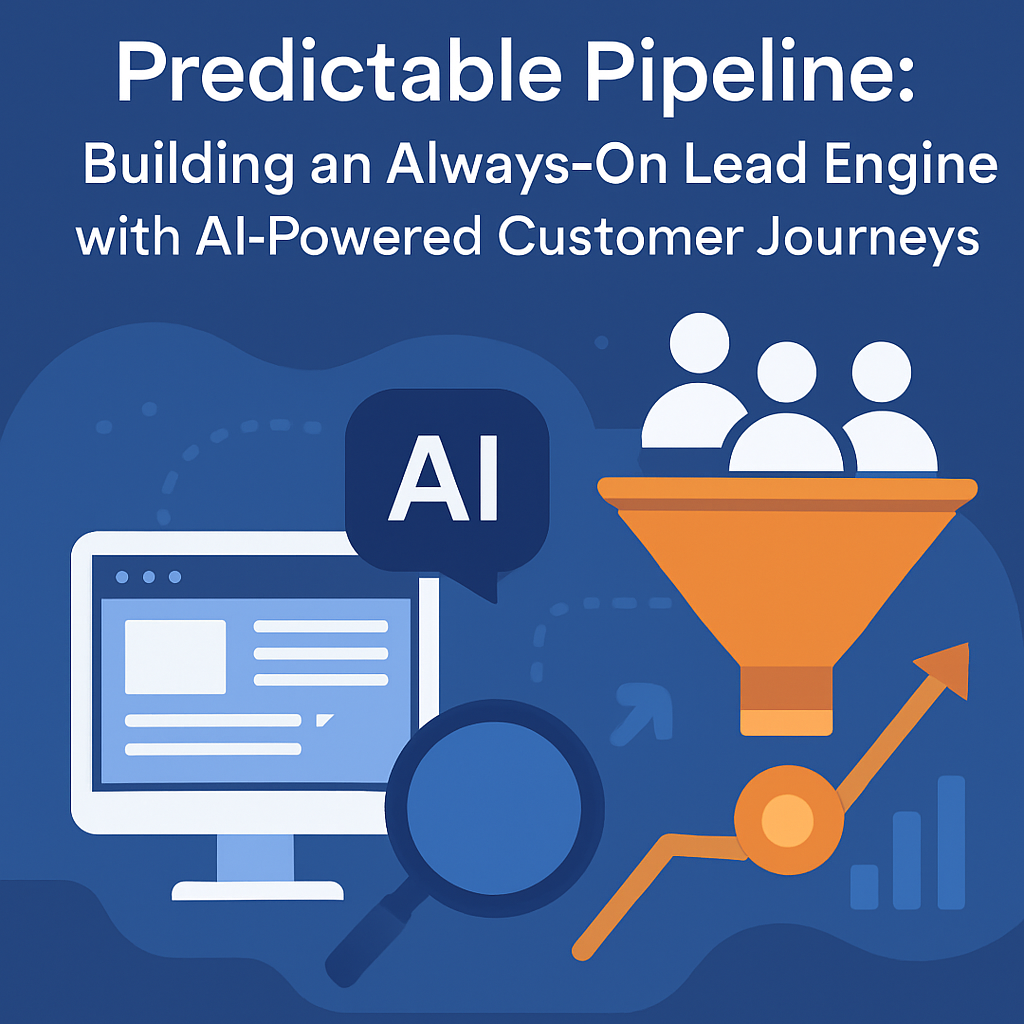In today’s competitive landscape, small businesses are increasingly looking for innovative ways to get ahead. One tool that is transforming how we understand and capitalize on business trends is predictive analytics. If you’re a small business owner in the service sector, be it B2C or B2B, predictive analytics can offer game-changing insights to drive growth and streamline operations.
Predictive analytics refers to the use of data, machine learning algorithms, and statistical models to predict future outcomes and trends in a business. It allows small businesses to analyze current data to make educated predictions about future customer behavior, market conditions, and business outcomes. Service-based businesses can leverage predictive analytics to optimize pricing strategies, enhance customer experience, or forecast demand, thereby improving operational efficiency and increasing profitability.
- The Basics of Predictive Analytics
- Why AI Makes Predictive Analytics More Powerful
- How to Achieve This Synergy
- How Small Businesses Can Benefit
- Challenges and How to Overcome Them
- Case Studies: Real-world Applications
- Implementing Predictive Analytics: A Step-by-Step Guide
- Your Roadmap to Anticipating the Future
Key Takeaways
- Predictive analytics analyzes current and historical data to forecast future events.
- AI enhances the capabilities of predictive analytics.
- Small businesses can benefit from predictive analytics in various areas like consumer behavior, seasonal trends, and operational inefficiencies.
While the concept may seem daunting, implementing predictive analytics in your business is more accessible than you might think. We have a treasure trove of insights and actionable steps to help you leverage this powerful tool for your business. Stay tuned to discover how you can make predictive analytics work for you.
The Basics of Predictive Analytics
Before diving deep, let’s understand what predictive analytics really is. Simply put, it’s a technique that utilizes machine learning and statistical algorithms to analyze both current and historical data. This analysis is then used to make accurate predictions about future events, customer behaviors, and market trends.
Why AI Makes Predictive Analytics More Powerful
While predictive analytics is undoubtedly a powerful tool, its abilities are exponentially increased when coupled with AI. Artificial Intelligence doesn’t just compute data; it understands, learns, and adapts. AI brings a level of sophistication that traditional predictive analytics models can’t achieve on their own. For instance, while predictive analytics might forecast that sales could rise during the holiday season, AI can pinpoint which products are likely to be the most popular based on nuanced consumer behavior and sentiment analysis.
How to Achieve This Synergy
- Integrate Natural Language Processing (NLP): AI’s NLP capabilities can sift through customer reviews, social media mentions, and other textual data to gather more qualitative insights, thus providing a richer context to your predictive models.
- Employ Deep Learning Algorithms: While predictive analytics relies on structured data, deep learning algorithms can analyze unstructured data, such as images or customer service audio recordings, to offer even more comprehensive business insights.
- Automate Real-Time Analysis: AI allows for the automation of real-time data collection and analysis, making your predictive models more dynamic. This real-time feedback loop means your business can adapt to emerging trends or issues much more quickly.
- Customization and Personalization: AI can personalize the customer experience by using predictive analytics to determine what products or services individual customers might be interested in, thereby increasing the likelihood of conversion.
- Risk Mitigation: Advanced AI models can predict and quantify risks, providing a more nuanced risk assessment compared to traditional methods. This is particularly useful in financial planning and cybersecurity.
By strategically combining AI with your predictive analytics, you not only make your forecasts more accurate but also more actionable. This synergy can be the cornerstone of a robust, data-driven strategy that propels your small business forward in a highly competitive landscape.
How Small Businesses Can Benefit
The scope of predictive analytics powered by AI isn’t limited to large corporations. Small businesses, particularly those in service sectors, can glean an array of benefits. Understanding consumer behaviors on a more intimate level helps create more targeted marketing campaigns. Seasonal trends can be predicted with greater accuracy, allowing for better inventory management. Furthermore, it helps in identifying potential operational bottlenecks before they become major issues.
The power of predictive analytics and AI lies in scalability. For small businesses looking to expand, these tools can forecast optimal locations for new outlets or identify underserved markets with a high likelihood of success. Even hiring decisions can be smarter; by analyzing past employment data and performance metrics, AI can help choose candidates most likely to excel. This data-driven decision-making was once only for large corporations, but advances in technology have made it accessible for small businesses. This democratization of advanced analytics levels the playing field, offering businesses a chance to compete effectively and make informed decisions.
Challenges and How to Overcome Them
Adoption of predictive analytics and AI isn’t without its challenges for small businesses. One of the primary hurdles is the technical know-how required for implementation. Additionally, the initial investment in adopting these technologies can be a concern.
While the upfront costs may seem daunting, it’s essential to view them in the context of the substantial return on investment (ROI) that predictive analytics and AI can offer. Over time, the efficiencies gained, the increased revenue from more targeted marketing, and the costs saved from preemptive operational adjustments can significantly outweigh the initial expenses. For instance, by identifying high-performing sales channels and customer segments, businesses can allocate resources more efficiently, getting more value for every dollar spent.
To mitigate challenges, consider starting with a defined scope and measurable objectives. You might also explore partnerships with specialized AI operations firms that can offer scalable, turn-key solutions aligned with your business goals. Such relationships not only help reduce the initial investment but also offer specialized skills to ensure maximum ROI. In the long run, the investment in predictive analytics and AI not only pays for itself but can become a cornerstone of your business’s competitive edge.
By starting small, measuring the impact, and scaling in a calculated manner—with the option of specialized guidance—you’re better positioned to navigate the initial challenges and unlock the long-term benefits.
Case Studies: Real-world Applications
To fully grasp the transformative power of AI-enabled predictive analytics, let’s dive into a couple of case studies that illustrate how different service-based businesses overcame unique challenges.
B2C Healthcare Provider – Initially, this business had issues with long patient wait times and difficulty in scheduling urgent appointments. By using AI to analyze past patient visits, they could predict when they would be busiest and adjust appointment slots and staffing levels accordingly. The initial investment in AI technology was rapidly offset by increased patient satisfaction and higher revenue from more efficient appointment scheduling.
B2B IT Consultancy – This firm was grappling with project overruns and missed deadlines, which affected client satisfaction. By employing predictive analytics, they were able to more accurately forecast project timelines based on a variety of factors like project complexity and team experience. This enabled them to set more realistic deadlines and manage client expectations better, leading to improved client retention and positive reviews.
Both examples illustrate that, while challenges are inevitable, the strategic use of predictive analytics and AI provides practical solutions that translate to long-term success and a substantial ROI.
Implementing Predictive Analytics: A Step-by-Step Guide
If you’re sold on the transformative potential of predictive analytics and AI, your next move is to get these technologies up and running in your business. Here’s a streamlined guide to help you navigate this journey.
- Identify the Key Metrics: Know precisely what you want to measure or predict. This could be anything from customer behaviors to inventory turnover.
- Select the Right Tools or Partner: While there are software solutions tailored for DIYers, you might also consider collaborating with an AI operations firm that specializes in predictive analytics. This will allow you to tap into expert knowledge, ultimately saving time and potentially increasing your ROI.
- Collect Data: Whether you go alone or with a partner, ensure you have ample, high-quality data for the most accurate analytics.
- Analyze and Adapt: Once the initial data has been crunched, it’s crucial to adapt your business strategies based on the insights garnered.
By following this guide, you’re not just implementing a technology; you’re setting the stage for long-term, data-driven success. Choosing the right tools or partner for this journey can be the difference between a smooth implementation and a rocky one.
Your Roadmap to Anticipating the Future
In this ever-changing business landscape, predictive analytics coupled with AI not only gives you a competitive edge but also empowers you to make well-informed decisions. By embracing these cutting-edge technologies, small businesses can craft highly efficient strategies, streamline operations, and elevate revenue streams.
Additional Resources
For a deeper understanding, I recommend the book “Data Science for Business” by Foster Provost and Tom Fawcett. You may also find valuable insights in articles from the Harvard Business Review on AI in business.
Chart Your Course with InkymaThe sheer potential of predictive analytics and AI is too vital to overlook. Why not take the next logical step by aligning with a specialist in AI operations? Inkyma is dedicated to helping businesses like yours make the shift to data-driven decision-making. Don’t leave your future to chance; anticipate it. Click the link at the top of the page to schedule a strategy session with us today.
How Difficult is it for Small Businesses to Implement Predictive Analytics and AI?
Implementing predictive analytics and AI in a small business is more accessible than ever, thanks to user-friendly platforms and a variety of pricing models. While the initial setup does require some technical knowledge, many small businesses overcome this hurdle by partnering with AI operations specialists. These experts can guide you through the process, from identifying key metrics to analyzing results, making it far easier to start benefiting from predictive analytics. Remember, the initial investment often yields a significant return on investment (ROI), especially in terms of strategic planning, operational efficiency, and revenue growth.












